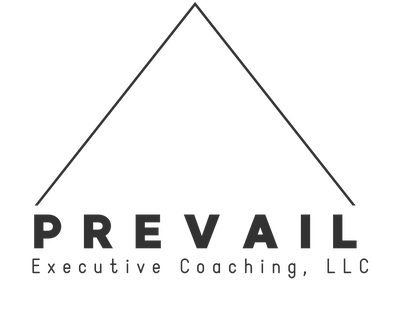
A REFLECTION ON LEADERSHIP
Coaching Employees for Goal Achievement
By Bruce - Prevail Executive Coaching
Servant leadership often includes coaching an employee in pursuit of a goal -- but how, exactly, do you do that? How can you improve the likelihood a goal-pursuing person will accomplish something meaningful? A good start is asking the question, "When you reflect on a past significant achievement, what were the behaviors that helped you overcome the obstacles and gain clarity, energy and grit?"
But coaching your employee, from developing a plan through achieving their goal, requires what I call, "the constellation of criteria for success." That constellation is formed by three powerful behaviors:
- Focus
- Effort
- Persistence
Because the trifecta of focus, effort and persistance will directly impact the likelihood of success for your employee, let's take a closer look at each one.
1. Focus
How to activate: Pinpoint clarity for what the person wants to accomplish and why
The most rewarding goals -- as well as the most frequently realized goals -- have emotional elements that fall into three categories:
A. Joyful
B. Masterful
C. Servantful
A. Joyful: Fulfills feelings of happiness through the positive effect of gratifying experiences. For example, Addison wants to join a committee to increase her visibility and friendships at work.
B. Masterful: Fulfills feelings of confidence through developing new capabilities. For example, Tyler wants to earn a professional designation.
C. Servantful: Fulfills feelings of altruism through making life easier for others. For example, Luann wants to contribute to her community by volunteering to install smoke detectors in low income and senior housing.
Bonus -- Epic Goal: A greater challenge that fulfills all three emotional elements. For example, Evie wants to save money to go backpacking in Spain (joyful), learn to speak Spanish fluently so she can interact with the locals (masterful), and use her Spanish-speaking skills so she can effectively communicate with her Spanish-speaking customers at work (servantful).
2. Effort
How to activate: Use "positive urgency" to generate action and start on the demanding path of goal achievement.
Positive urgency is the energy and enthusiasm to take swift action and generate progress toward accomplishing a task or goal. How can you create positive urgency? By visualizing how it would look and feel when crossing the finish line of success.
The vision must be compelling enough to break the force field of familiarity and stability. Only then will the goal-pursuing person invest the time, attention and energy necessary to create forward momentum and gain the desired flywheel effect. After all, it takes less effort to maintain inertia than to stop and restart. If you've ever run a 10K fun run (not an oxymoron!), you know that it's easier to slow down and walk rather than stop and rest.
For example, Jeremy is committed to earning a project management certificate, so he created an enthralling vision of the positive emotions he will experience when he passes the exam. Jeremy harnessed these emotions to fuel his initiative for promptly enrolling in a project management course and developing a routine of attending class regularly.
3. Persistance
How to activate: Create a risk management strategy that anticipates setbacks and mitigates disruptions; and create a support system that provides motivation and inspiration when self-doubt sets in and willpower weakens.
The good news about long-term goals is the fact they're, well, long term. The bad news is that they're more susceptibile to unplanned events; however, they also create more opportunities for building the muscle of resiliency by repeatedly overcoming adversity.
For example, Britney has a goal to earn her MBA before she's forty. Prior to starting the arduous adventure she considered the myriad of obstacles that could jeopardize her plans:
What if she wasn't smart enough to keep up with her cohort?
What if she didn't have solid study habits and couldn't retain the information?
What if she couldn't manage her test anxiety and failed to pass the exams?
What if she couldn't meet expectations at both work and school?
What if her kids, partner, parents, or even she became sick and had to pause her coursework?
What if she lost her school funding and had to scramble to find another way to pay for it?
Identifying the risks in advance creates the opportunity to consider an appropriate response for each peril before it strikes.
The more demanding the goal, the more likely the need for persistance. A support system will provide encouragement, accountability, and feedback, meaning this is your opportunity, as a team leader, to be part of the goal-pursuing person's ecosystem. If Britney were your employee, you should use your 1:1 meetings to regularly check in on her progress. Ask open-ended questions to prompt her conversation:
Since we last met, what you learned that was most challenging?
What has been most interesting?
What worries you about your studies?
What excited you about your studies?
Would it be helpful if I provided feedback when I see you applying your learnings at work?
How may I help you, if at all, with your MBA program?
One more thought about persistence. A lot of mental and emotional suffering comes from the way we talk to ourselves, so practicing the mantra of positive self-talk will drown out the negative self-talk. Pre-planning for damaging self-talk can help with switching the script from negative to positive and provide motivation to push through to the end. For example, Meghan relies on the mantras of "I can," "I will," and "I must" to fortify her resolve.
Helping another person develop their ability to activate their focus, effort and persistence is a rewarding endeavor. Your leadership and coaching will be more impactful as you share the path of goal achievement through these three powerful behaviors. As you cultivate the cadence of goal achievement, let me know what you discover.
Prevail Executive Coaching
Visit prevailexecutivecoaching.com for more information

